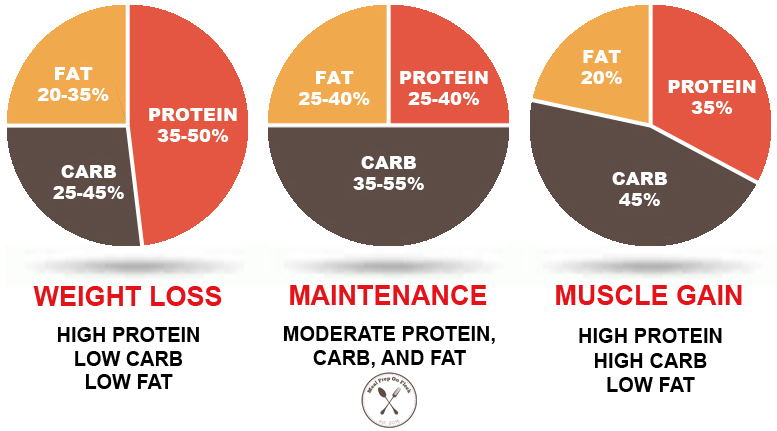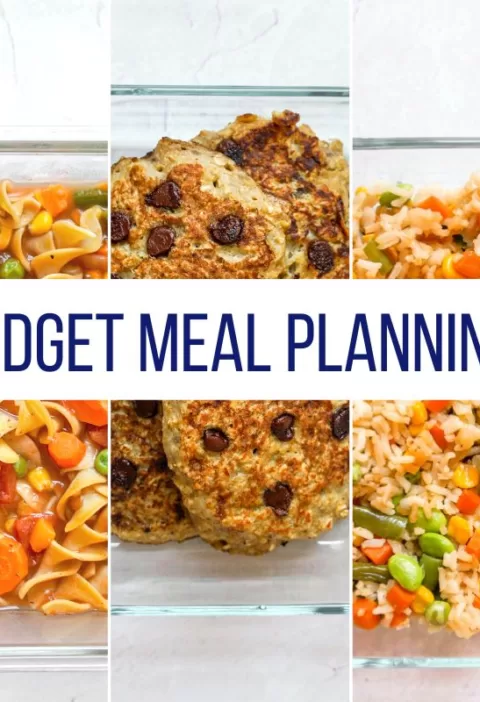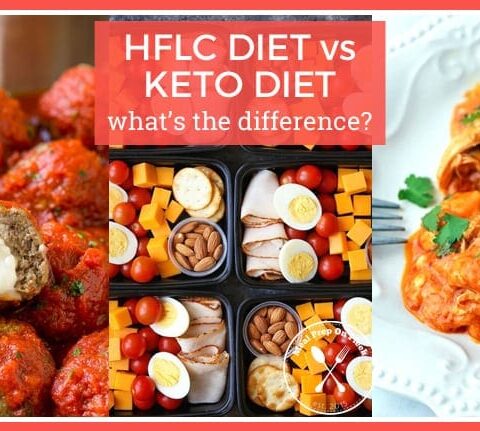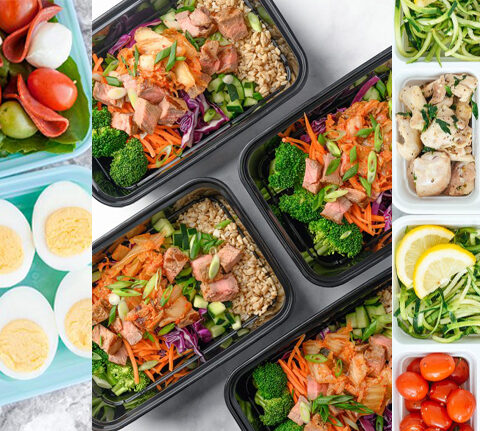Macro calculator for weight loss, macros for muscle gain, macros for life! Confused? You've come to the right place. We've got everything you need to know to help you reach your goals!
Almost all of us have heard something about macros lately. The talk about "if it fits your macros" is all over social media and highly promoted by some of the biggest fitness industry leaders. Macro calculators for weight loss are all over the Internet. (We've got a macro calculator, too!) This philosophy is becoming popular very quickly due to its flexibility with the foods you eat. No longer are the days of eating healthy foods like chicken and broccoli and hoping for the best in terms of weight loss. You need a macro calculator for weight loss.
There are many reasons why you might want to know about macros. Often, people calculate macros because they want to lose weight, gain muscle, or maintain their weight. Understanding macros can help you develop a better relationship with food or achieve an overall healthier lifestyle.
- What The Heck Are Macros?
- Macros: Carbohydrates
- Macros: Protein
- Macros: Fat
- Other Macros
- The Ultimate Guide to Calculating Macros
- How do I calculate macros?
- Macro Calculator Sample Food
- Macro Calculating and Tracking Tips
- Macro Percentages: What Macro Ratio Should I Use?
- Macros for Weight Loss
- Macros for Muscle Gain
- Macros for Weight Maintenance
- Tips for Macros and Meal Prepping
- The 411 on Macro Calculating
What The Heck Are Macros?
So, you're probably wondering what a macro is, right?
Macro is short for macronutrient, "a chemical element or substance (such as potassium or protein) that is essential in relatively large amounts to the growth and health of a living organism," according to Merriam-Webster. The ones that people think about the most, with regard to weight loss and weight gain, are carbohydrates, protein, and fat.
Macronutrients provide the energy to carry out our human functions. Let's take a look at the three big ones: carbohydrates, protein, and fat to help you better understand how to calculate macros for weight loss (among other reasons)!
RELATED: Learn more with our exclusive Meal Prep on Fleek course about macros!
Macros: Carbohydrates
Think potatoes, fruit, bread, oatmeal, potato chips, sugar, etc. Those all contain carbohydrates They are all of the sugars, starches, and fibers you would find in your fruits, veggies, grains, and even dairy products. They are not, despite what some food media would have you believe, inherently evil.
Their job is to provide energy for our central nervous system and energy to our muscles. They are critical to our brain function and also influence our mood and memory! Have you ever had a bowl of ice cream and then felt happy? Thank those carbs! They are a key player in mental health.
Carbohydrates can be broken down into two types—simple and complex.
- Simple Carbohydrates are broken down quickly by the body. They are found naturally in foods such as fruit and dairy, along with sugar, and processed foods such as candy and soda.
- Complex Carbohydrates are broken down more slowly by the body; hence, they are complex. Foods such as beans, vegetables, and whole grains such as oats all contain complex carbs.
Macros: Protein
The second type of macronutrient is protein. Proteins are long chains of amino acids that make up your muscles, skin, bones, hair, nails, etc. Without protein, your organs cannot exist, and protein is super important for both muscle growth and repair.
Most protein is found in animal sources such as poultry, meat, eggs, and dairy. However, you can also find protein in plant-based foods such as beans, tofu/tempeh, nuts, seeds, nutritional yeast, and quinoa.
Macros: Fat
No, we're not talking about body fat, but dietary fat. The last (and usually scariest) macronutrient is dietary fat. Like carbohydrates and protein, dietary fat is also essential to life. Like carbohydrates, dietary fat is an energy source. Your body will store up fat and use it as energy once your carbohydrate reserves have been depleted. Have you ever started to feel tired during a workout and then get a second wind? Your fat stores just kicked in! Fats can be found in foods such as nuts, seeds, oils, butter, fatty meat, and fatty fish.
Like carbohydrates, dietary fats are also broken down into different categories. We have two main types:
- Good Fats. These include monounsaturated fatty acids found in oils, polyunsaturated fatty acids found in plant-based foods and omega-3's found in fish.
- Bad Fats. These include saturated fats found in animal products and full-fat dairy products. They also include trans fats that come from oils that have undergone processing, i.e, partially hydrogenated oils.
Other Macros
Although water and fiber are not macronutrients, they are two important factors in the "if it fits your macro" philosophy. That's because water is essential for life and fiber is critical for digestion. Fiber also regulates our blood sugar and keeps us feeling full and satiated, which discourages overeating. Sufficient water intake also prevents things like headaches and, more importantly, dehydration. These may not be part of your macro calculator for weight loss per se, but they're still important to consider.
The Ultimate Guide to Calculating Macros
How do I calculate macros?
Now that we know what macros are and why they are important, let's look at how to calculate them.
Before we delve into the macro calculator explanation, you will need to know that:
- Proteins have 4 calories per gram
- Carbohydrates have 4 calories per gram
- Fats have 9 calories per gram
RELATED: Check out the Meal Prep on Fleek body fat calculator!
If you are looking at packaged foods, you can find the grams of carbohydrates, proteins, and fats for each serving on the nutrition label. If you do not have a nutrition label available you can usually find the correct nutrition for something like chicken breast or salmon by doing a simple Google search with something like, "What are the macronutrients for 4oz of chicken breast" or referencing the USDA food database.
Ready to try this out? Use our Meal Prep Macro Calculator for weight loss and more!
Macro Calculator Sample Food
Let's take a look at the nutrition label Melissa's Produce Black Eyed Peas for a greater understanding of macros and how they work.
This item contains:
- 19g carbohydrates
- 8g protein
- 2.5g fat
Based on our knowledge that there are 4 calories per gram in carbohydrates and protein and 9 calories per gram in fat, each half-cup serving yields the following in terms of macros:
- 76 calories from carbohydrates (19g x 4 calories per gram)
- 32 calories from protein (8g x 4 calories per gram)
- 22.5 calories from fat (2.5g x 9 calories per gram)
Macro Calculating and Tracking Tips
If you are working with specific macronutrient goals, it is important to measure and/or weigh your food with a food scale to ensure accuracy in portion sizes. Otherwise, your macro calculations for weight loss won't be accurate. It's amazing how small a serving of nut butter or cereal is! Tracking and calculating is tedious, yes, but important for overall weight loss goals. It's so easy to underestimate what you're eating.
You can use tools such as My Fitness Pal or Lose It! to easily calculate and track your macronutrients each day. These apps allow you to input your food and their amounts into each meal and then tell you the total number of each macronutrient that is in that meal. You can also keep track of additional information such as fiber, sodium, water, etc.
Here is an example of what a My Fitness Pal daily log might look like:
The downside to these apps is that the macronutrient calculations are a bit more generic instead of customized to you. If you are looking for a more customized plan, you can reach out to a health and wellness coach to help you.
Macro Percentages: What Macro Ratio Should I Use?
To figure out your macronutrient goals for each day, you will need to start by calculating your daily calorie requirements. Again, this can be done through a customized plan or on our Meal Prep Macro Calculator. Once you have your recommended calorie intake, you can then figure out what the best ratio of carbohydrates, protein, and dietary fat would be, based on your goals.
Macros for Weight Loss
For weight loss, it is usually best to go with a ratio that's higher in protein and lower in fat and carbohydrate. The standard combo is typically 25%-45% carbohydrates, 35%-50% protein, and 20%-35% fat.
Macros for Muscle Gain
For muscle gain, you will want a higher carbohydrate and protein ratio to fuel your workouts. Your ratio should be around 45% carbohydrates, 35% protein, and 20% dietary fat.
Macros for Weight Maintenance
You can increase your fat and carbohydrate consumption a bit. Carbohydrates may range 35%-55%, protein 25%-40%, and fat 25%-40%.
Tips for Macros and Meal Prepping
Once you have your calorie needs and macronutrient ratios figured out, it's time to start planning to reach those goals. There are so many reasons why you should be meal prepping; for starters, it saves you time and money!
Meal prepping also helps you become intimately familiar with what portion sizes look like.
If you are new to meal prepping then our easy-to-follow article, Meal Prep 101 For Beginners is a great place to start! I
For recipe inspiration, switch up your breakfasts for one of these 25 Make-Ahead Breakfast Ideas or change up your lunches with a Non-Salad Lunch recipe! If you're ready to go all in, try these 35 Macro Friendly Meal Prep Recipes.
And don't forget to make meal planning fun! Put on some music, get out your favorite kitchen gadgets, and enjoy a few hours of meal prepping on Sunday, or whatever day makes sense for you! For many, meal prepping/cooking/baking is very therapeutic.
The 411 on Macro Calculating
What we've put together here is merely an introduction to macronutrient calculations. When starting a macronutrient plan, you will find that you may end up tweaking numbers over the first few weeks, and you may find that you need to adjust things as you lose weight or change your exercise regime.
And everyone is different, so keep that in mind if you're counting macros with friends. Some people find that they work more efficiently on a high-protein or high-fat diet, while others are better on higher carbs. With that said, please use the numbers above as a guideline, not an exact science.
Over time, it will become easier to find the right ratio that works for you and your lifestyle. Please be patient with yourself when starting this plan. Over time, you'll find the right balance that gives you enough energy to make it through your day and leave you feeling satisfied—all while attaining your fitness goals.
Additional Resources.
If you are still unsure how to calculate macronutrients to achieve your goals or are looking for more customized guidance, apply for our coaching program HERE and we'll help you get setup with macros that will speed up your time to results!
*These should not be eliminated from your diet. They should be used mindfully when planning.







Thank you Ive learn alot now i got to figure out to do my macros.
Hey Sarah,
Very informative article. I like the way you have explained it in detail.
Thank you! keep sharing such articles.
Thank you!
[…] you’re new to counting macros and want more info, Meal Prep on Fleek has a ton of helpful […]
Thanks for the informative article. I am wondering about the difference in counting raw vs cooked ingredients. Should all be raw values, or is it ok to mix? Does it matter much in the greater scheme of things?
Hi Riette,
We always reference raw unless otherwise specified. It does not matter if you opt to measure in raw or cooked, as long as you are always using one or the other. As an example: 4 ounces of raw chicken actually comes out to about 3-3.25 ounces of chicken after it is cooked.
I need to lose weight
Michelle - While we do not makee any guarantees about weight loss, if you think there are areas of your meal prep routine that can be improved, in order to help you reach your goals, you'll want to check out our Meal Prep Course here: https://meal-prep-on-fleek.thinkific.com/courses/meal-prep-master-course
I am trying to get into shape and cut back on unhealthy foods, so thanks for sharing this. I like your point about tracking calories and macronutrients using an app. I might need to start doing this so I can keep better track of what I'm eating.
Glad you found it helpful Derek!
Sarah, I think you are a great teacher through the medium of writing. I've seen a lot trying to understand macros and you are the best I've found. Thank you.
Roy
I appreciate that, Roy. Thank you.
Hi, I'm trying to find an app where I can test out a meal to find out what the macros look like before preparing and adding as a meal. I'm using fatsecret but would like to do 'what ifs' for meals instead of doing in my head or pen and paper. Thanks!
Hi Sherry, unfortunately, we do not know of an app that does this. My Fitness Pal has a section where you can do it, but it goes into the recipe data base. You would need to delete it if you would like it removed.
I use MyFitnessPal for this. It’s easy to edit and adjust if needed.
So not helpful! This article seemed like it was going to FINALLY explain how to calculate macros in percentages... but instead it was just another, same-old, scientific overshare.
Hi Mark, we are sorry that this did not provide the information that you were looking for. Is there something we can help answer for you?
What is the best type of macro calculator to use to calculate your own macros so you can customize your numbers to make sure you meet your macros daily
We have a great one on our website: https://mealpreponfleek.com/macro-calculator/
This is just a life changing info thanks very much
I have been doing a lot of research on the Keto diet and your percentages are a little different than I have been following. My goal is weight loss. I have been following the 70%fat, 25% protein, and 5% carbs. How do I know what is right??
Hi Dawn, This article doesn't share percentages for a keto diet. It shares basic percentages with no specific dietary needs. We always recommend doing what's best for you!
What is the point of click baiting helpful information then charging people for it?
Hi Steve,
There is no charge to use our macro calculator!
Question: The amount of Carbs being recommended by the Macro Calculator, is that Total Carbs or Net Carbs?
These are Total Carbs.